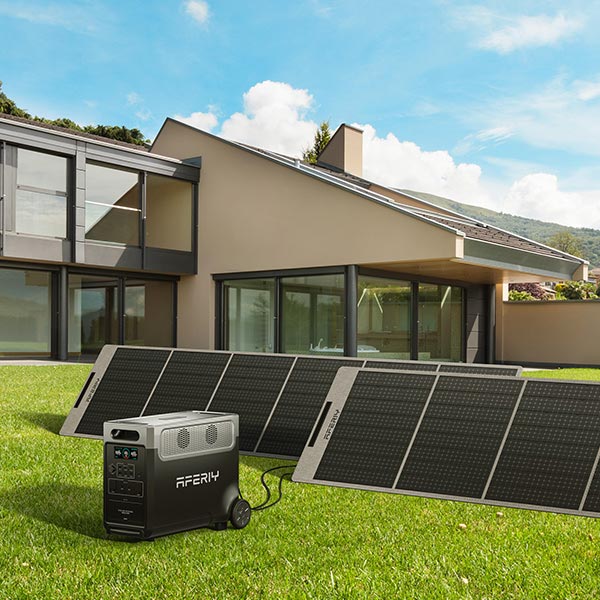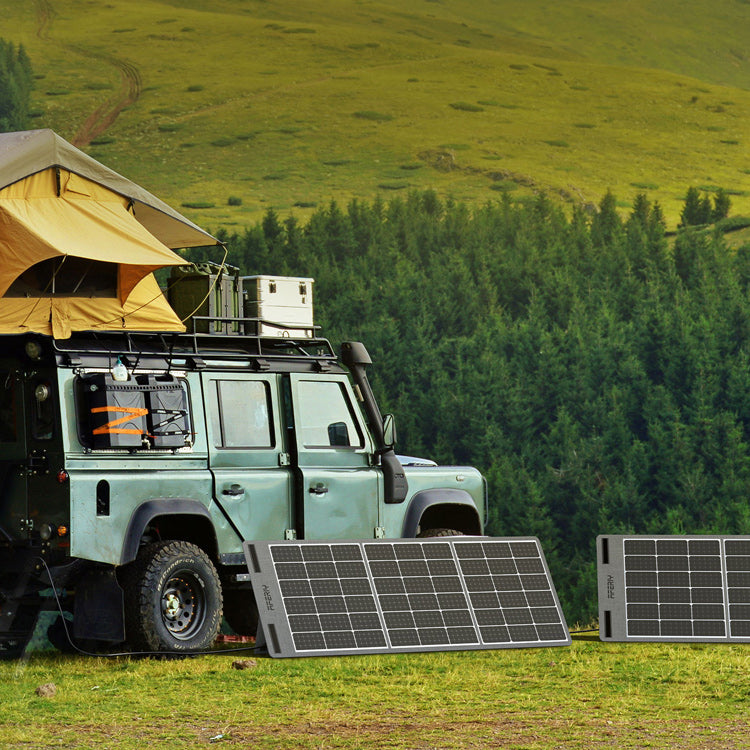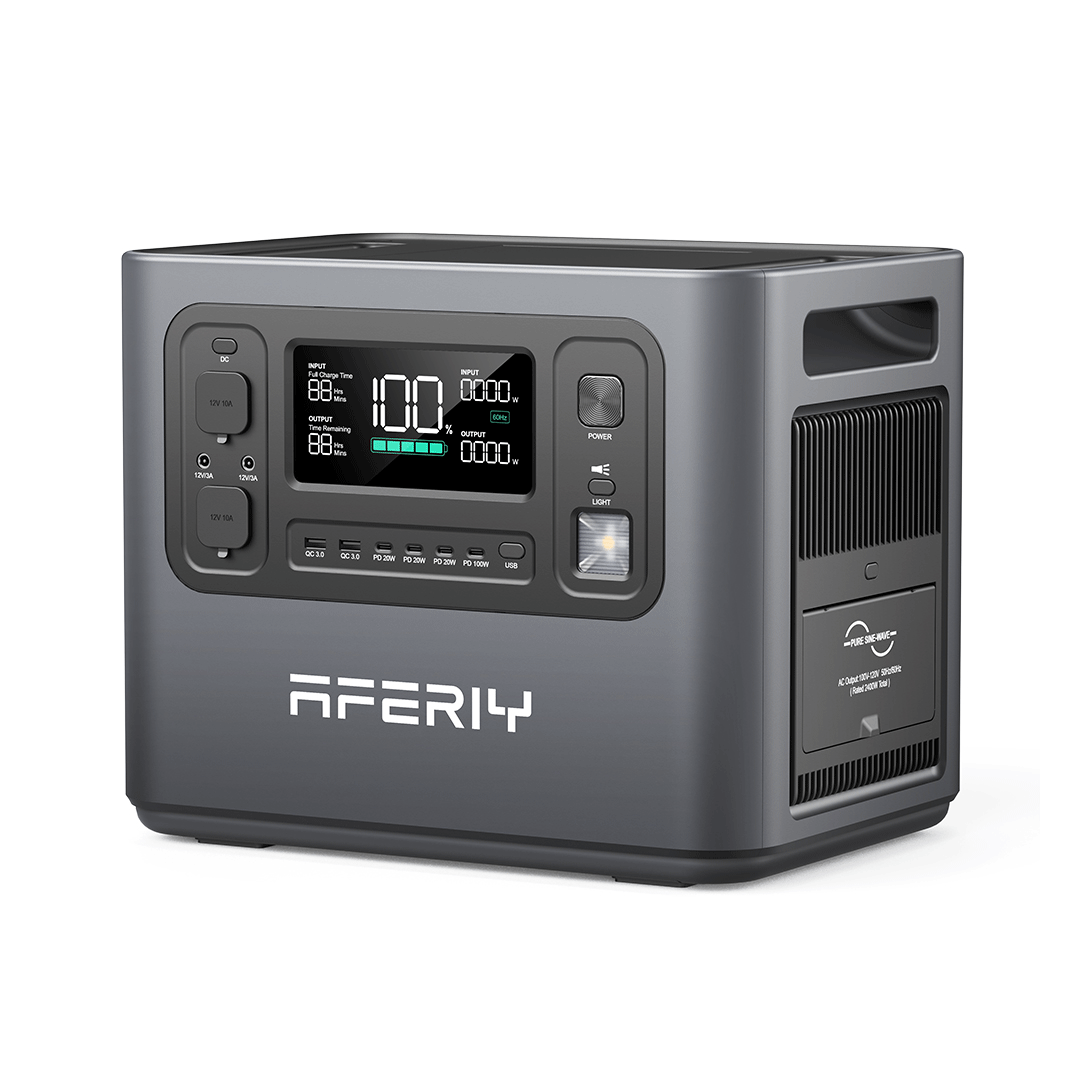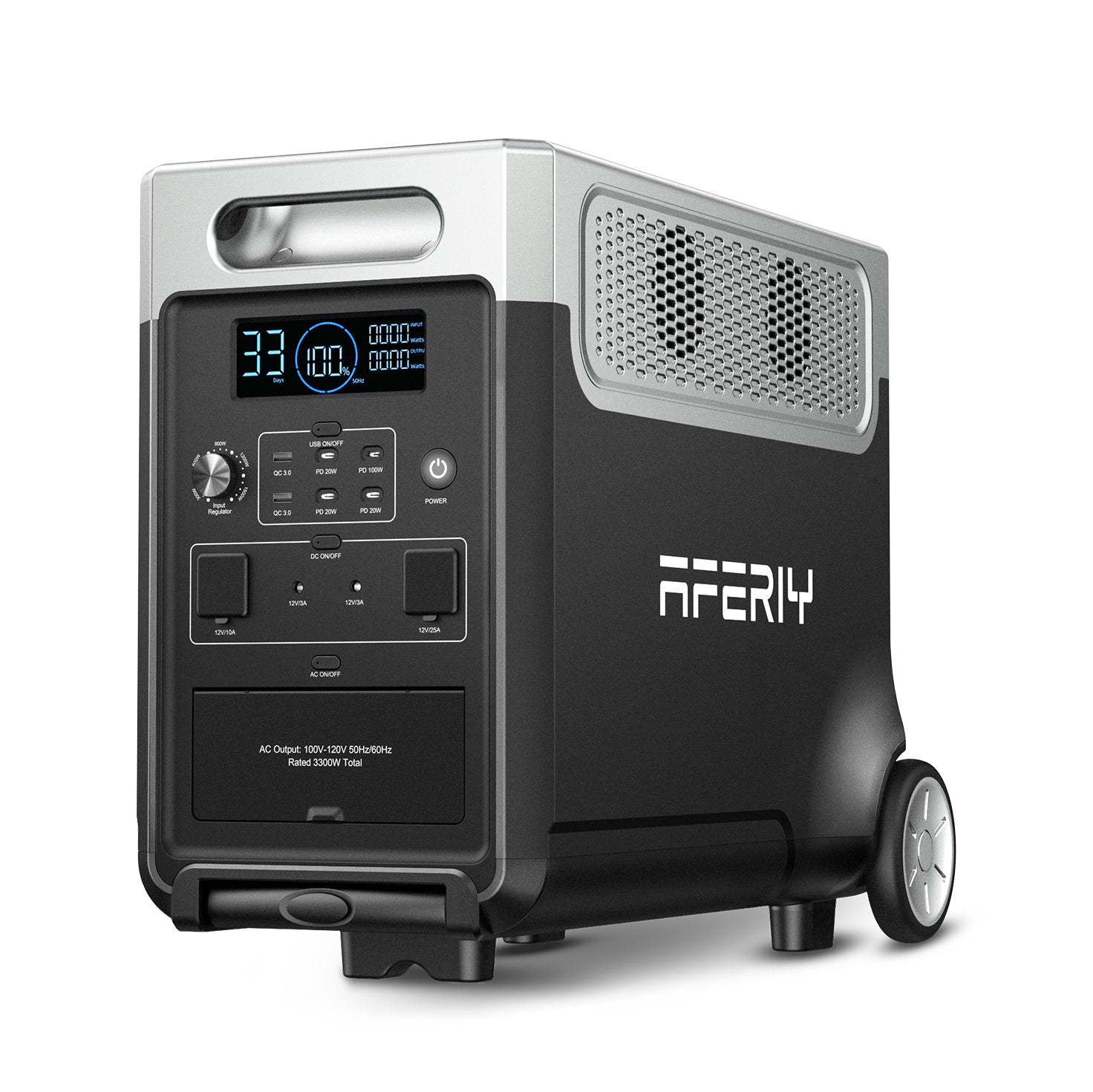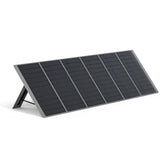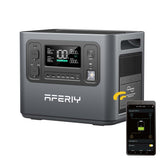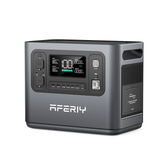-
AFERIY AF-S400A1 400W Portable Solar PanelHigh 400W Solar Input Monocrystalline Silicon Solar Cells 23% High Solar Conversion Efficiency Durable EFTE Coating and IP65 Waterproof Material With Foldable and Portable Design, Easy to Install and Carry Easy Setup with Adjustable Kickstand USB A + Type C PD3.0+ DC Output Ports to Fast Charge Directly Series or Parallel Connections are Available Compatible With AFERIY AF-P110, P210, P310, 2001A, 1201A; Eco-Friendly, Emission-Free, Free and Renewable Energy 3 Years Long Warranty
- $549.00
$699.00- $549.00
- Unit price
- per
Save $150.00 -
AFERIY AF-S200A1 200W Portable Solar PanelFast Charging with High 200W Solar Input; Monocrystalline Silicon Solar Cells, 23% High Energy Conversion Efficiency; Highly durable ETFE coating; IP65 Waterproof Rating; Portable, One-piece Foldable Design for Easy Transport and Carry; With Adjustable Kickstand for Easy Installation or Angle Adjustment; With 5 Output Port, It Can Directly Charge 5 Devices; such as Laptop Cell Phones Tablets Camera; Compatible with all AFERIY Portable Power Station; Flexible for Outdoor Camping, Off Grid, RV and Backyard use; No Emissions,Non-polluting, Free, Clean and Renewable Energy 3 Years Warranty;
- $269.00
$349.00- $269.00
- Unit price
- per
Save $80.00 -
AFERIY AF-S100 100W Portable Solar PanelUpgraded Monocrystalline Cells, 23% High Solar Conversion Efficiency; Multi-Layer materials and MWT Technology offer Outdoor Durability and Longer Life; IP65 Waterproof Rating; Portable, One-piece Folding Design for Easy to Carry Transport; Self-supporting, Simple and Speed Setup with Adjustable Kickstand; Compatible with Most Solar Generators with MC4 Connectors; Perfect for Camping, RV, Fishing, Hiking and Backyard; 3 Years Warranty;
- $149.00
$199.00- $149.00
- Unit price
- per
Save $50.00
Recently Viewed Products
Example product title
- $19.99
- $19.99
- Unit price
- per
Example product title
- $19.99
- $19.99
- Unit price
- per
Example product title
- $19.99
- $19.99
- Unit price
- per
Example product title
- $19.99
- $19.99
- Unit price
- per
Example product title
- $19.99
- $19.99
- Unit price
- per
Example product title
- $19.99
- $19.99
- Unit price
- per
Example product title
- $19.99
- $19.99
- Unit price
- per
Example product title
- $19.99
- $19.99
- Unit price
- per
Example product title
- $19.99
- $19.99
- Unit price
- per
Example product title
- $19.99
- $19.99
- Unit price
- per
FAQs
Can portable solar panels charge my smartphone and laptop?
Yes, portable solar panels are designed to charge small electronic devices like smartphones and laptops. They convert sunlight into electricity using photovoltaic cells and typically come with USB or DC output ports suitable for charging your gadgets. When using portable solar panels, it's important to ensure their wattage and output voltage match your device's requirements for efficient charging.
However, charging times depend on sunlight intensity, panel size, and device battery capacity. High-quality portable solar panels with integrated charge controllers optimize energy transfer, protecting your devices from overcharging or voltage fluctuations. Using these panels during outdoor activities or emergencies provides reliable power for your essential electronics.
However, charging times depend on sunlight intensity, panel size, and device battery capacity. High-quality portable solar panels with integrated charge controllers optimize energy transfer, protecting your devices from overcharging or voltage fluctuations. Using these panels during outdoor activities or emergencies provides reliable power for your essential electronics.
Can portable solar panels be used off-grid or during camping?
Absolutely! One of the primary benefits of portable solar panels is their suitability for off-grid use and camping. Their lightweight and compact design allows you to carry them easily to remote locations, providing a clean and renewable energy source. Whether you’re camping, hiking, or traveling, portable solar panels offer a convenient way to power your devices without relying on traditional electricity.
By setting up portable solar panels in direct sunlight, you can charge power banks, batteries, or even small appliances. They allow you to stay connected and keep your devices operational in off-grid environments, enhancing safety and comfort during outdoor adventures.
By setting up portable solar panels in direct sunlight, you can charge power banks, batteries, or even small appliances. They allow you to stay connected and keep your devices operational in off-grid environments, enhancing safety and comfort during outdoor adventures.
How long does it take to charge a device using portable solar panels?
The charging time using portable solar panelsdepends on several factors, such as panel wattage, sunlight intensity, and the battery capacity of the device you want to charge. For example, a smartphone with a 3000mAh battery might take between 2 to 6 hours to fully charge under ideal sunlight using a small portable solar panel.
Larger devices like laptops will require more time or higher wattage portable solar panels to achieve a full charge. Additionally, weather conditions and the angle at which sunlight hits the panel impact charging speed. Understanding these variables helps you better plan your energy needs when using portable solar panels outdoors.
Larger devices like laptops will require more time or higher wattage portable solar panels to achieve a full charge. Additionally, weather conditions and the angle at which sunlight hits the panel impact charging speed. Understanding these variables helps you better plan your energy needs when using portable solar panels outdoors.
Are foldable solar panels easy to carry during outdoor activities?
Yes, foldable solar panels are specifically designed for portability and ease of use during outdoor activities. Their compact folding design allows them to fit into backpacks or travel bags without adding significant bulk or weight. This makes foldable solar panels ideal for camping, hiking, or any situation where carrying lightweight and efficient power sources is essential.
Besides portability, the durable materials used in foldable solar panels ensure they withstand the rigors of outdoor use. You can unfold them quickly to capture sunlight and charge your devices efficiently, making them a practical choice for adventurers and travelers.
Besides portability, the durable materials used in foldable solar panels ensure they withstand the rigors of outdoor use. You can unfold them quickly to capture sunlight and charge your devices efficiently, making them a practical choice for adventurers and travelers.
Are foldable solar panels compatible with most portable power stations?
Most modern foldable solar panels are designed to be compatible with a wide range of portable power stations, allowing you to store the solar energy they generate. Compatibility depends on matching the output voltage, connectors, and wattage requirements between the foldable solar panels and the power station.
Using foldable solar panels with portable power stations enhances your off-grid power capabilities by providing a renewable charging source. This setup allows you to charge devices even when direct sunlight isn’t available, ensuring a continuous power supply during extended trips or power outages.
Using foldable solar panels with portable power stations enhances your off-grid power capabilities by providing a renewable charging source. This setup allows you to charge devices even when direct sunlight isn’t available, ensuring a continuous power supply during extended trips or power outages.
Can folding solar panels be connected together for more power?
Yes, many folding solar panels come with connectors that allow you to link multiple panels in parallel or series to increase total power output. Connecting several folding solar panels expands your energy generation capacity, which is particularly useful for powering larger devices or charging batteries faster.
When combining folding solar panels, ensure that their specifications are compatible and that you use appropriate cables and controllers. This modular approach provides flexibility, allowing you to customize your solar setup based on your energy needs and available space.
When combining folding solar panels, ensure that their specifications are compatible and that you use appropriate cables and controllers. This modular approach provides flexibility, allowing you to customize your solar setup based on your energy needs and available space.
Are folding solar panels suitable for emergency power backup?
Folding solar panels are an excellent option for emergency power backup due to their portability and ability to generate clean energy anywhere in sunlight. They can charge batteries or power stations that store electricity, which can then supply power during outages or natural disasters.
Having folding solar panels as part of your emergency preparedness plan ensures you have a renewable and quiet energy source. Their ease of transport and quick deployment make them highly practical for unexpected situations when traditional power sources fail.
Having folding solar panels as part of your emergency preparedness plan ensures you have a renewable and quiet energy source. Their ease of transport and quick deployment make them highly practical for unexpected situations when traditional power sources fail.
How much energy can a typical solar panel panel produce?
The energy output of a typical solar panel panel depends on its size, type, and efficiency. Most residential solar panels produce between 250 to 400 watts under optimal conditions. Over a full day of sunlight, a single solar panel panel can generate several kilowatt-hours of electricity, enough to power household appliances and reduce reliance on the grid.
Factors like shading, orientation, and geographic location influence actual energy production. Investing in high-quality solar panel panels and proper installation maximizes energy harvest, contributing to cost savings and environmental benefits.
Factors like shading, orientation, and geographic location influence actual energy production. Investing in high-quality solar panel panels and proper installation maximizes energy harvest, contributing to cost savings and environmental benefits.
What are the main types of solar panel panels available?
The main types of solar panel panels include monocrystalline, polycrystalline, and thin-film panels. Monocrystalline panels are made from single-crystal silicon, offering high efficiency and longevity. Polycrystalline panels consist of multiple silicon crystals, usually at a lower cost but with slightly less efficiency. Thin-film panels are lightweight and flexible but typically less efficient.
Choosing the right solar panel panels depends on your energy goals, budget, and installation space. Each type has distinct advantages, so understanding their characteristics helps you select the best fit for your needs.
Choosing the right solar panel panels depends on your energy goals, budget, and installation space. Each type has distinct advantages, so understanding their characteristics helps you select the best fit for your needs.
How do I clean and maintain folding solar panels?
Proper cleaning and maintenance of folding solar panels ensure they operate at peak efficiency. Regularly wipe the surface with a soft, damp cloth to remove dust, dirt, or debris. Avoid abrasive materials or harsh chemicals that might damage the panel coating. Cleaning is especially important after exposure to dusty or rainy environments.
Storing folding solar panels in a dry place and avoiding excessive bending beyond the designed folds preserves their longevity. Inspect the panels periodically for wear or damage, and handle connectors carefully. Good maintenance practices help your folding solar panels provide reliable power for years.
Storing folding solar panels in a dry place and avoiding excessive bending beyond the designed folds preserves their longevity. Inspect the panels periodically for wear or damage, and handle connectors carefully. Good maintenance practices help your folding solar panels provide reliable power for years.
- Choosing a selection results in a full page refresh.

